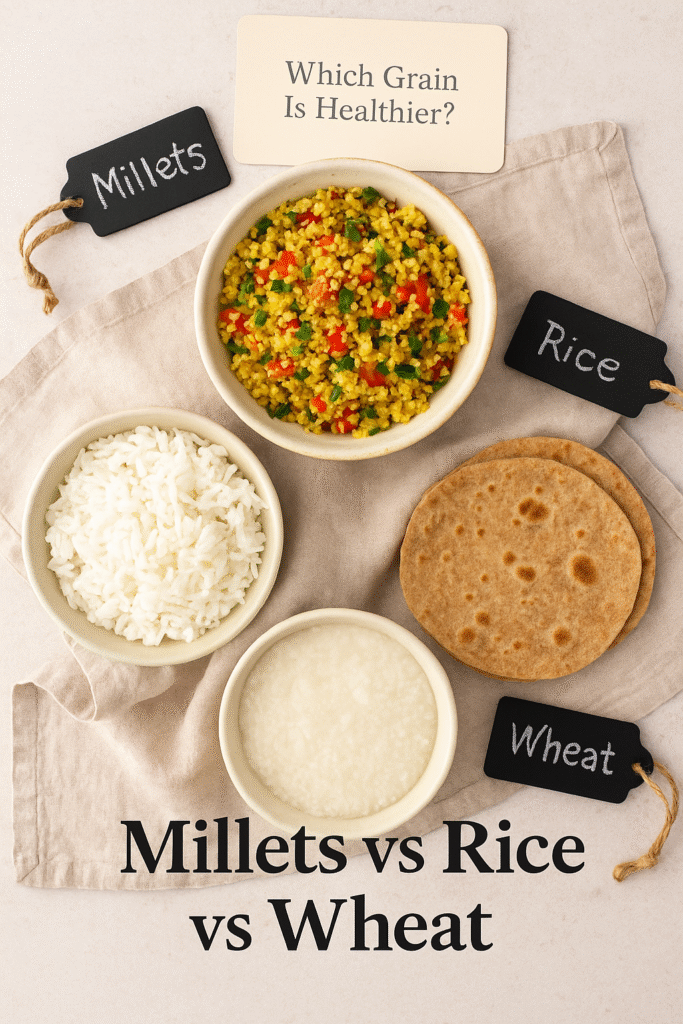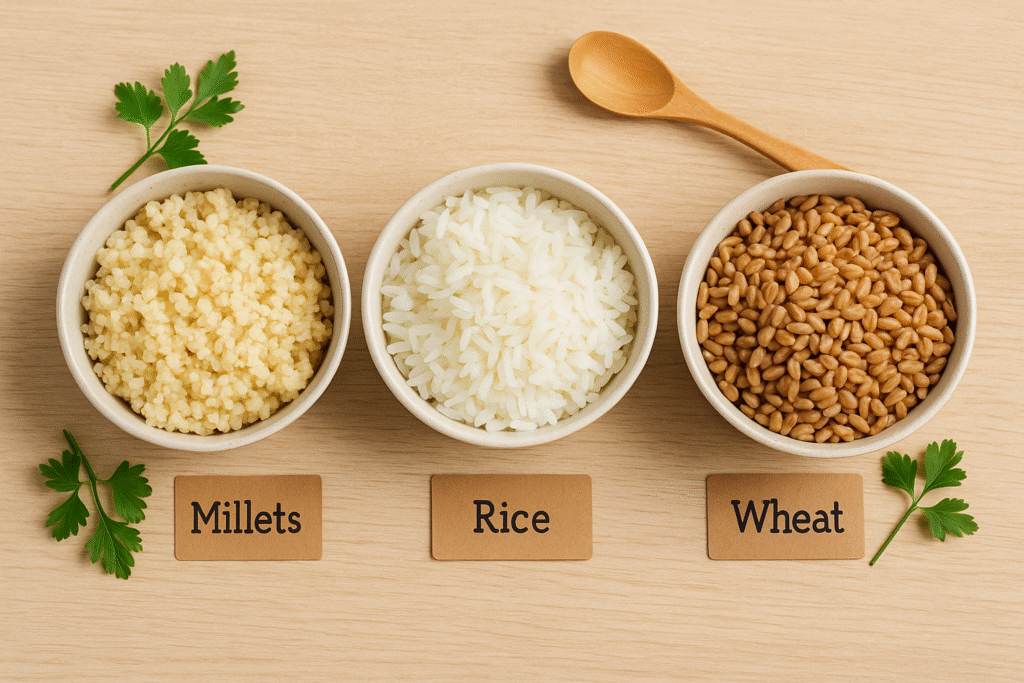When we compare millets vs rice vs wheat, the decision isn’t just about taste—it’s about health. Your staple grain can affect your fibre intake, micronutrients, glycaemic index and even how full you feel. So, if you’ve ever asked “which grain is healthier millets rice wheat?”, stick around. We’ll break it down simply, no jargon.
Nutritional breakdown of each grain
Millets
For whole grain millets, you get a nice boost of nutrition. They tend to have higher dietary fibre and better micronutrients than many refined grains. One review says millets have almost double the fibre content of rice and a much richer profile of essential amino acids. For example, millets contain minerals like magnesium, iron and phosphorus in greater amounts.
They’re also naturally gluten-free, which helps folks who are sensitive to gluten.
So for nutrition profile millets rice wheat, millets score high in fibre, minerals and protein.
Rice
Rice, especially the refined white version, is a go-to grain for many. It gives fast energy because it’s easily digestible. But the downside is that when rice is refined you lose a lot of bran and germ—and with them lots of nutrients. The review by the team at Dr Mohan’s Diabetes Specialities Centre points out: rice provides quick energy but loses nutrients during processing.
If you pick whole-grain or brown rice you get more fibre and nutrients, but still millets tend to lead in that aspect.
Wheat
Whole wheat is a widely consumed grain and has its benefits: decent fibre, B-vitamins, minerals and is easily available. But there are two main caveats: if you eat refined wheat flour (white flour) you lose many nutrients; and wheat contains gluten, which may be problematic for some individuals.
In terms of the “whole grain millets wheat rice benefits” discussion, whole wheat definitely has benefits, though perhaps not as pronounced as millets when you compare fibre and micronutrient richness.
Glycaemic index and blood sugar impact of grains
Let’s talk about glycemic index (GI) and how it influences blood-sugar levels when comparing millets rice wheat comparison health.
GI is a scale that ranks how quickly a food raises blood sugar after you eat it.
Here are key points:
- Several studies suggest millets have a lower GI compared to refined rice or wheat. For example, one study comparing a millet-based dosa vs rice-based dosa found the millet GI = 59.25 vs rice GI = 77.86. PMC
- Another review indicated millets show GI scores between about 40-70, which is generally lower than refined grains.
- One Indian chart gives: barnyard millet GI ~42.3, white rice GI ~89. Kauvery Hospital
So if you’re thinking about millets rice wheat for weight management and blood sugar, millets often help more because slower digestion = better control.
Specific health advantages and concerns by grain
Millets
Advantages:
- High fibre content can help you feel full longer, good for weight control. (From “whole grain millets wheat rice benefits”).
- Low GI helps smooth out blood-sugar spikes. Good for metabolic health.
- Gluten-free, so friendly for those with gluten sensitivity.
Concerns: - May require different preparation or cooking methods than rice/wheat.
- Some processed millet forms may lose benefits if refined heavily.
Rice
Advantages:
- Quick energy source. Many people digest it easily.
- Widely available and culturally integrated.
Concerns: - White rice has low fibre and fewer nutrients than whole grains.
- High GI versions can cause sharper blood sugar rises, not ideal for weight or glucose control.
Wheat
Advantages:
- Whole wheat gives good fibre, B-vitamins, decent nutrition in many diets.
Concerns: - Gluten-containing: for people with celiac or non-celiac gluten sensitivity that’s a big issue.
- If you pick refined wheat (white flour), you lose much of the benefit.

Environmental & sustainability aspects of grain production
When you consider sustainable grains water footprint, millets vs rice vs wheat again shows clear differences.
Millets are typically drought-tolerant, need less water, grow in harsher conditions.
Rice often needs large amounts of water in paddy fields; wheat too demands certain inputs like fertilisers and water. So if you care about sustainability (beyond just your plate), millets give extra value.
How to choose the “healthier” grain for you
There’s no absolutely perfect grain for everyone. It depends on your goals. Here’s a simple guide:

- If your goal is blood sugar control or weight management, then choosing a grain with higher fibre and lower GI (like many millets) may serve you better.
- If you have gluten sensitivity, pick millets (gluten-free) or rice rather than wheat with gluten.
- If you feel good eating rice or wheat and you pick whole-grain versions, that’s still beneficial—so don’t ditch them completely.
- Always check how it’s processed: whole vs refined makes a big difference. Whole grain = better.
- Variety matters: you may include millets, whole-wheat, brown rice in rotation rather than pick one “best” only.
Practical ways to include each grain in your diet
- Try replacing your usual white rice once or twice a week with a millet like foxtail or barnyard. Simple pilaf or khichdi style.
- If you eat wheat roti, try making one rotation with millet flour or mixed millet + wheat flour.
- For rice lovers: pick brown or un-polished rice instead of white; add veggies and protein to lower the overall GI of the meal.
- Keep portion size mindful. Even healthy grains can contribute too many calories if overeaten.
- Mix grains: e.g., half millet + half rice in a dish gives you familiar texture but better nutrition.
Summary of findings & practical take-away
When you compare millets vs rice vs wheat, millets tend to come out ahead in terms of fibre, micronutrients, and often glycaemic impact. Rice is fine for quick energy but refined versions lose out nutritionally. Whole wheat is a solid choice, but gluten and processing matter.
So the key: pick whole-grain versions, include variety, match to your health goals, and yes you might lean more on millets if your priorities are blood sugar or weight control.
Try one grain swap this week: replace your usual rice or wheat with a millet meal. See how you feel: hunger, energy, digestion. Track it. If you want deeper guidance, consider discussing with a nutritionist.
Conclusion
When you look at millets vs rice vs wheat, millets often come out as the healthier option—especially if your goal is better glycaemic control, higher fibre, micronutrients and sustainability. That said, whole wheat and brown rice still have value, so don’t feel you must ditch them. Rather mix it up, pick whole-grain forms, stay mindful of portions, and consider your own health goals and sensitivities. Try that millet swap this week and see how you feel.
FAQs
Which grain has the most fibre: millets, rice or wheat?
Millets tend to have considerably higher dietary fibre compared to refined rice and often more than wheat. For example one review notes that the quantity of dietary fibre in millet is almost double that in rice.
Are millets better for blood sugar than rice or wheat?
Yes, millets often have a lower glycaemic index and higher fibre content, which helps slow glucose release. White rice and refined wheat may cause quicker blood sugar spikes.
Is whole wheat healthier than millets?
Whole wheat is a good choice with fibre and B-vitamins, but compared to millets many millet types offer higher micronutrients and are gluten-free, which may benefit some individuals.
Can I replace rice or wheat entirely with millets?
You can include millets as a regular part of your diet, replacing rice or wheat in many meals, but balance and variety matter most rather than full replacement. Processed forms and how they’re prepared also affect benefits.
What about wheat if I have gluten sensitivity?
If you are gluten sensitive or have celiac disease, wheat (which contains gluten) may cause issues; many millets are naturally gluten-free and can be safer alternatives.
Does the type of rice or wheat (whole vs refined) matter?
Absolutely. Whole-grain rice or whole wheat retain bran and germ with more fibre and nutrients, while refined (white rice, white flour) lose much of those benefits.
Which grain is best for weight management?
Grains with higher fibre and slower digestion (such as many millets) help you feel fuller longer, which may support weight management better than highly processed rice or wheat.
Are there any downsides to eating millets?
While millets are nutrient-dense, they can have different texture/flavour, may require different cooking methods, and some varieties may still spike blood sugar if processed heavily or eaten very large portions.
How does the environment favour one grain over the others?
Millets typically require less water and grow in more challenging conditions, making them more sustainable compared to rice and wheat in many regions.
Which grain should I pick if I have diabetes?
For someone managing diabetes, choosing a whole-grain millet can be a strong option due to lower glycaemic impact and high fibre. But always consider individual health status, portion size, and overall diet pattern.

